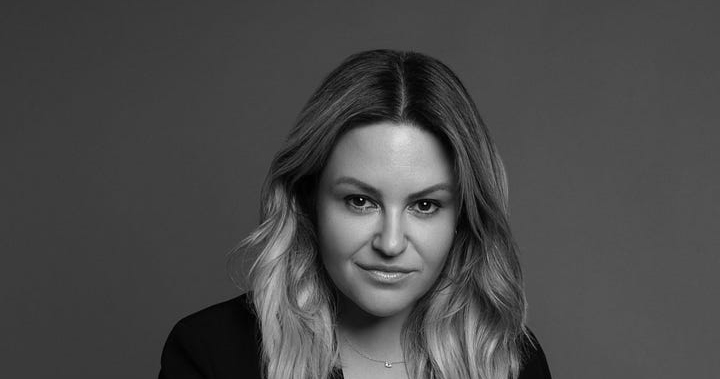Validate — Show empathy and connection through validation of an experience.
The number one leadership initiative in any organization today is improved coaching. Coaching empowers employees, empowerment drives engagement, and engagement drives performance. At its core, coaching is about transformation. Leading distributed teams requires transforming how we coach and changing our play calls and playbooks to get things done. As a part of our interview series called “Moving From Command & Control to Coaching & Collaboration; How Leaders and Managers Can Become Better Coaches,” we had the pleasure to interview Thea Raskin.
Thea Raskin is a creative executive recruiter, leadership coach and Founder/CEO of The Inventory, a People Consultancy based in Los Angeles that is focused on helping people develop the skills to navigate their creative and professional career. Her combined 20 year career in advertising, design, recruitment and coaching have provided her with the expertise to consult executives on a myriad of challenges organizations face in recruitment, retention and “upleveling.”
Thank you for joining us to explore a critical inflection point in how we define leadership. Our readers would like to get to know you better. What was a defining moment that shaped who you are as a leader?
I think when I did “the work.” Which took years of learning and introspection to do and I’m still working on. It was just an opportunity to do lots of self reflection work that often times we don’t have the tools to access that information. It allowed me to see myself through a more objective lens. Another critical point was when I went to coaching school to get certified. The tools you learn elevate your abilities to lead from a place of understanding and a win-win mentality.
John C. Maxwell is credited with saying, “A leader is someone who knows the way, goes the way, and shows the way.” How do you embody that quote as a leader?
I’m a big believer that business is a team sport and the key to success is winning together by embodying a collaborative culture. And to have a collaborative culture, people need to learn by example and be supported as they trip and fall. And know it’s okay to do that and it’s likely the way they will learn the best!
How do you define the differences between a leader as a manager and a leader as a coach?
A manager executes someone else’s vision and leads to compliance in others. A coach is self-directed and leads to engagement and empowerment in others.
We started our conversation by noting that improved coaching is the number one leadership initiative in any organization today. What are some essential skills and competencies that leaders must have now to be better coaches?
Oh gosh- where to start! I would say the top ones that come to mind are listening more, asking more questions, and having a dialogue with your peers and subordinates. Accountability and vulnerability as a leader are also strengths that leads to trust, and trust is the #1 metric of a successful team. Without trust, the relationship erodes and business falters.
We’re all familiar with the adage, “You catch more flies with honey than with vinegar.” How are you inspiring — rather than mandating — leaders to invest in upskilling and reskilling?
“Leveling up” is a commitment to investing in yourself and there really is no better investment in your portfolio than the investment of you. I think the authenticity of how I live and breathe this work either resonates with someone or it doesn’t, but in my experience most people at a certain level of leadership know this intrinsically as a necessity to success, not just in business but in life. I very rarely find someone who does not think it’s a worthy investment — it is more of a question of when, not if.

Let’s get more specific. How do you coach someone to do their best work? How can leaders coach for peak performance in our current context? What are your “Top 5 Ways That Leaders and Managers Can Be Effective Coaches?”
- Validate — Show empathy and connection through validation of an experience.
- Communication — Ask people what they need. Literally. Get used to asking “What is it that you need?” especially in moments after you have acknowledged their pain point. There is a need underneath you need to uncover.
- Listen — Hold space for someone to speak and truly listen. What is it that is behind what they are saying? What are they trying to communicate to you?
- Accountability — The culture gets set at the top. If you take accountability for your mistakes, others will feel safe to do so as well without fear of repercussions. It is imperative that no one feel infallible. And it all starts at the top.
- Show humanity — Remember everyone has a family and other things going on. It doesn’t mean it is an excuse, but treating others as a whole and understands the multiple balls one juggles goes a long way.
We’re leading and coaching in increasingly diverse organizations. And one aspect of workforce diversity on the rise is generational diversity. What advice would you offer about how to effectively coach a multi-generational workforce? And how do you activate the collective potential of a multi-generational workforce?
The key to coaching a multi-generational workforce starts with respect. And once again- listening. It comes down to understanding that they both bring value to the total team and to have reverence for each in their own right. This means having each have a “voice” and an open environment that supports healthy conflict.
You’re referring to emotional intelligence, in a sense. What are two steps every leader can take to demonstrate a higher level of emotional intelligence?
Empathy and self regulation. To have empathy you need to embody an open mind and willingness to not “be right” per se but “to learn.” Self regulation is all-encompassing in that it shows a sense of self awareness, maturity, boundaries and social skills. As a leader, many balls and fires get thrown at you — it does not always mean you need to react immediately. Taking some time to sort through all of the variables while you gather more information is sometimes the best course of action.
Words matter. And we’re collectively creating a new leadership language right now. What are the most important words for leaders to use now?
Hmmm…leadership words tend to sound trite when overused. I would encourage open ended questions more than specific words. Without that, you can’t understand the thought pattern behind someone’s decision, and without knowing, you really can’t have a productive healthy conversation to get to the best mutual outcome.
I keep inspiring quotes on my desk. What’s your favorite “Life Lesson Quote,” and why does it mean so much to you?
I don’t have a favorite but I do keep this quote on my desk which someone told me and it really stuck — “You can only be as authentic as you’re willing to be vulnerable”. I think the connection between vulnerability, authenticity and trust is so powerful and something that is at the cornerstone of society and community. And ultimately business, since business is about relationships.
Our readers often like to continue the conversation. What’s the best way for readers to connect with you and to stay current on what you’re discovering?
LinkedIn is a great place to stay connected — https://www.linkedin.com/in/thearaskin/
Our website is www.theinventory.xyz for more information.
Thank you for sharing your insights. We appreciate the gift of your time and wish you continued success and good health.


